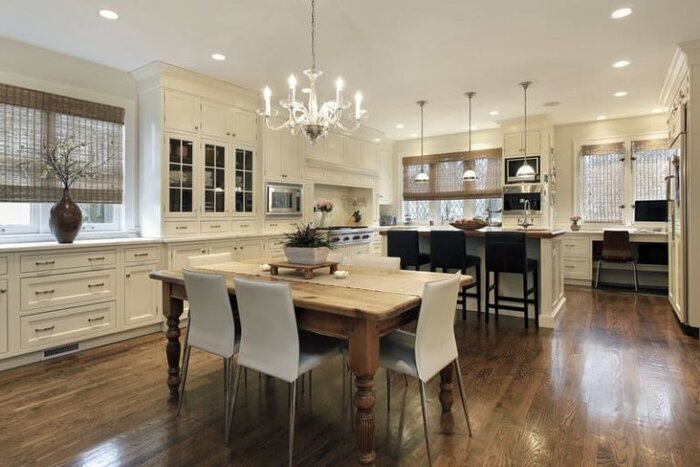
There are many reasons why it’s best to hire licensed contractors when replacing insulation of any kind. First and foremost, it ensures you adhere to building codes designed to keep you and your family safe from fire and other risks. And, as increasing numbers of homeowners opt to use eco-friendly insulation and lighting designs, it’s essential to understand that certain types of insulation are flammable when installing with recessed lighting options.
Recessed lighting is touted for its fixtures’ invisible nature in interior design, and its ability to provide task, safety, and ambient lighting potential when installed with a dimmer. Because the recessed cans are installed in cylindrical canisters, they produce something called a chimney effect.
Just as a chimney relies on its design to direct smoke out of a fireplace via the laws of thermodynamics (heat moving into cold pockets), recessed cans create a similar effect. When installed without proper insulation and sealing, warm air from your home moves in an upward draft, traveling through the canisters into the interior wall or attic spaces and eventually out of your living space. As a result, your HVAC system has to work much harder to maintain comfortable interior temperatures.
However, if the bulbs in the cans overheat and temperatures are elevated enough, any surrounding materials can ignite if they are flammable enough.
There are two things you can do to avoid unnecessary fires stemming from heated, recessed cans. The first is to know which insulation materials are the most flammable. Unfortunately, some of the most eco-friendly types of insulation are the most flammable. If you are building a sustainable home, you’ll want to know your options so you can opt to use less-flammable insulation around any recessed lighting fixtures.
The most flammable insulation materials is cellulose. Also referred to as loose-fill cellulose insulation, the small cellulose particles are flammable and can ignite if they’re directly exposed to an overheated recessed can or electrical spark. The small insulation particles are predominantly made using recycled paper with a fire retardant. They are rated to 450° F, but smaller, older particles can smolder or catch on fire at lower temperatures.
This doesn’t mean that you shouldn’t use cellulose insulation. Rather, keep that insulation in the attic and other areas away from recessed cans and use a different, less flammable option around recessed lighting fixtures.
Rock wool (also called mineral slag or mineral wool) is the safest, least-flammable insulation option around recessed cans. It is fire-rated for up to 1800° F, so there is no way an electrical issue or a heated lighting fixture can cause it to catch fire. As you can imagine, this insulation type is regarded as the least flammable and most fire-resistant insulation option available. It rivals that of asbestos insulation (no longer legal in the U.S.), without any of the associated health risks.
Rock wool is more expensive than other eco-friendly alternatives, so budget-conscious homeowners could opt to select a cheaper alternative for the attic, exterior walls, and crawl spaces, only using rock wool to surround the recessed cans.
The next best options are fiberglass batts or sheets, without the paper backing. Fiberglass batts and rolls are still considered the American standard for safe, affordable insulation (although you should always cover up and wear gloves, a mask and safety goggles when handling it to avoid inhalation, penetration, or ingestion of fiberglass particles).
Your lighting solutions are as important as your insulation choices. Work with a licensed, qualified electrician when selecting new lighting fixtures for your home or workplace and before installing the insulation.
Lighting fixtures have different rating tiers, based on their interaction with insulation. non-IC rated fixtures are compatible with higher-wattage bulbs, but they also have the highest fire risk when paired with the wrong insulation.
If you opt to use non-IC-rated fixtures with insulation, there should be at least three inches of space between the fixture and the insulation. This requires the use of a special cover or an insulation dam – and the insulation’s fire rating is important.
IC-rated (insulation contact rating) fixtures are designed to be surrounded by insulation. However, to prevent the risk of fire, IC-rated recessed cans can only support lower-wattage bulbs. While this may be fine for nighttime safety or ambient lighting, it may not be bright enough to serve as task lighting.
While installing less-flammable insulation is one way to minimize fire risk, installing ICAT fixtures is the best solution of all. While more expensive than their more standard counterparts, ICAT (insulated ceiling air-tight) fixtures are designed to seal internally. This prevents the drafts that cause the need for insulation in the first place.
The sides of ICAT canisters remain completely cool, so you can use caulk around them, and they can come in contact with any insulation – including cellulose – without the risk of fire.
The hotter your bulbs get, the more fire risk there is. Using LED or fluorescent lighting, both of which are on the cooler side, will further minimize fire risk when compared with incandescent bulbs.
Want to make sure you’re making the safest insulation choices for your household? Contact us here at Attic Solutions. We have decades of experience removing and replacing insulation in Bay Area homes and businesses.